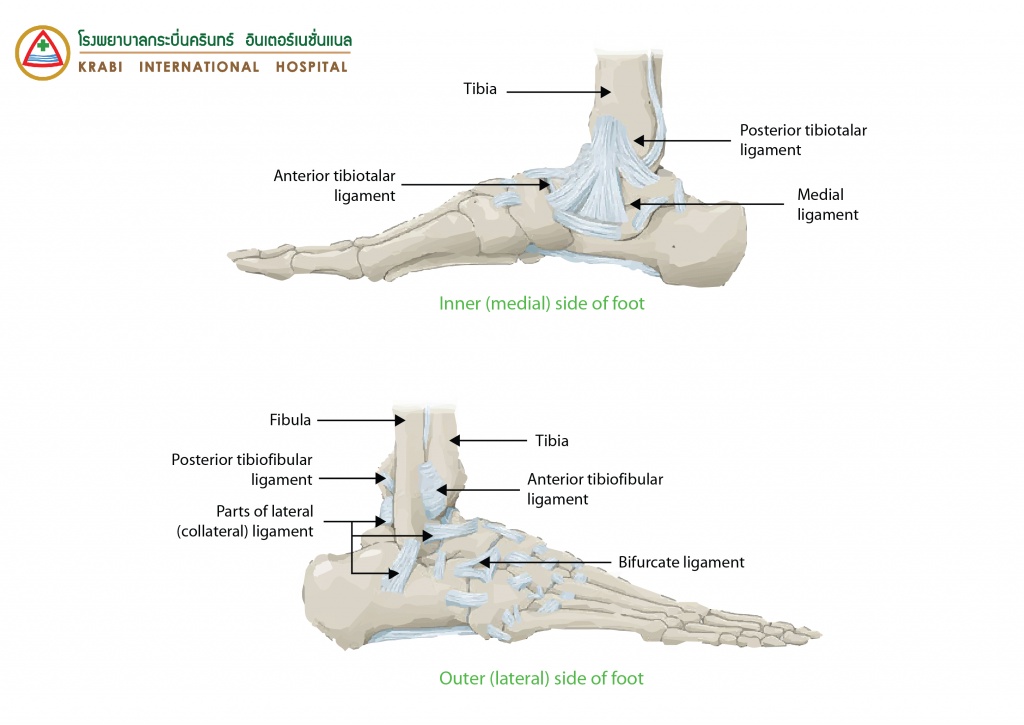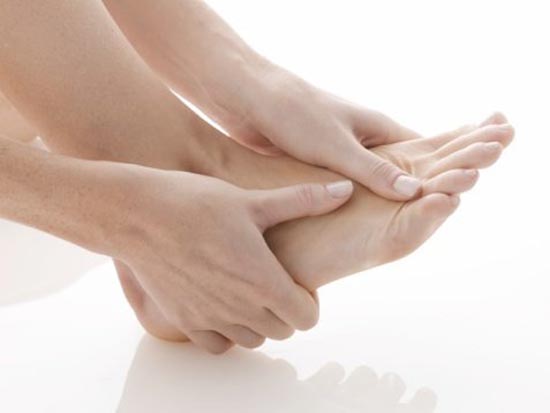Sprained Ankle
Sprained ankle
Produced by Dylan Merkett, Bupa Health Information Team, January 2012. This factsheet is for people who have a sprained ankle, or who would like information about it.
A sprained ankle occurs when a ligament is excessively stretched, twisted or torn. A ligament is a tough, flexible, fibrous tissue that connects one bone to another to form a joint.
About sprained ankles
Sprained ankles are classified into the following grades.
-Mild (grade I) – stretched or partial tear of a ligament with no loss of ability to put weight on your injured foot.
-Moderate (grade II) – incomplete tear of a ligament with moderate loss of ability to put weight on your injured foot.
-Severe (grade III) – complete tear of a ligament which may result in total loss of ability to put weight on your injured foot.
-Insert illustration: The ankle joint (All original illustrations can be downloaded from our file sharing web site. Contact the Health Information Team for log in details).
Symptoms of a sprained ankle
The symptoms associated with a sprained ankle include:
-pain
-swelling
-bruising
-restricted movement
-limited ability to put weight on the injured foot
A sprained ankle can be very painful with the pain getting worse if you move your foot. Your ankle will start to swell immediately and will be tender to touch. Bruising will appear around the injury but this can take hours or even days to appear. If your sprain is severe, you may not be able to put any weight on your foot.
You may hear a popping or cracking sound at the time of injury. Although this can be alarming it isn’t usually a sign of the severity of your injury.

Causes of a sprained ankle
A sprained ankle is most commonly caused by your foot twisting inwards making the ligaments on the outside of your ankle stretch past their normal range. This is known as an inversion sprain.
A sprained ankle can be caused by:
-walking on irregular surfaces
-losing your balance while wearing high heels
-an impact on your ankle during sports
-landing awkwardly from a jump
You’re more likely to sprain your ankle if you have done so previously. This is possibly because the ligaments didn’t heal properly the first time so they are weaker. It may also be because you damaged nerves in your ankle previously and if not fully rehabilitated the muscles can remain weak.
Diagnosis of a sprained ankle
Your doctor or physical therapist (physiotherapist) will ask about your symptoms and examine you. He or she may also ask you about your medical history and to describe exactly how you injured your ankle.
Your doctor or physical therapist will want to rule out a broken bone (fracture) and assess how severe your injury is. He or she may ask you to walk a few steps to see if you can put weight on your foot. This will help your doctor decide the best treatment for you.
You may need an X-ray if your doctor thinks your injury is severe and may need more specific treatment.
Please note that availability and use of specific tests may vary from country to country.
Treatment of a sprained ankle
It’s important that you begin to treat your sprained ankle as soon as possible. This will speed up your return to activity and reduce the chance of it happening again.
Self-help
In the first 48 to 72 hours after your injury, it’s important to follow the PRICE procedure. Many minor sprains and strains will respond well to this.
-Protect your injury from further harm.
-Rest your injury for the first two to three days, and then re-introduce movement so you don’t lose too much muscle strength.
-Ice the injured area using an ice pack or ice wrapped in a towel to reduce swelling and bruising. Don’t apply ice directly to your skin as it can damage your skin.
-Compress the area by bandaging it to support the injury and help reduce swelling. The bandage should fit snugly but not be too tight, and you should remove it before going to sleep.
-Elevate the injured area above the level of your heart to control swelling. Keep the area supported and try to keep it elevated as much as possible until the swelling goes down.
If your injury doesn’t improve, it’s important to seek advice from your doctor or physical therapist.
For the first 72 hours there are certain things you shouldn’t do. These can be remembered using HARM.
– Heat. Don’t use heat packs, hot water bottles or heat rubs on the affected area, as well as saunas or hot baths. Heat encourages blood to flow to the area, the opposite effect of using ice.
– Alcohol. Don’t drink alcohol because it can increase bleeding and swelling to the area, slowing down the healing process.
– Running or any other form of strenuous exercise. Such activities may cause more damage.
– Massage. This can increase bleeding and swelling.
As soon as you feel that your pain is tolerable, begin gentle stretching exercises to keep your ankle moving and help decrease the pain and swelling.
Doing five repetitions of the following exercises, three to five times a day, can help you to get back the movement in your ankle in all directions.
-Achilles tendon stretch. Sit on the floor with your injured leg stretched out in front of you. Loop a towel around the ball of your foot and gently pull your toes towards your head while keeping your leg straight. Hold for 20 to 30 seconds.
-Alphabet exercise. Try to draw the letters of the alphabet in lower case and upper case on the floor with your big toe.
Your doctor or physical therapist will probably give you exercises to do once you can stand without pain. These exercises will aim to strengthen the muscles around your ankle making a repeat injury less likely.
Medicines
You can take paracetamol (acetaminophen) immediately to help relieve pain and swelling. Your doctor may prescribe codeine if your pain is severe.
Always read the patient information leaflet that comes with your medicine and if you have any questions, ask your doctor or pharmacist for advice.
Physical therapy (physiotherapy)
Physical therapy can help restore your range of movement, strength and balance. This can be done with a number of techniques, such as:
-massage
-ultrasound
-joint and nerve mobilisation
-exercises to increase your range of movement, strength and balance
-assisting in returning you to a specific sport
-taping or having a brace placed around your ankle
Surgery
Surgery for a sprained ankle is rare because there isn’t enough evidence to suggest that it’s more effective than physical therapy and exercise. However, if your ankle is still causing you pain and giving way after you have tried all physical therapy options, your doctor may refer you to an orthopaedic surgeon (a doctor who specialises in bone surgery) or a sports injury specialist.
Availability and use of different treatments may vary from country to country. Ask your doctor for advice on your treatment options.
After your treatment
The length of time it takes you to recover from a sprained ankle will depend on how severe your injury is.
If you don’t have any complications, you will probably be able to walk within one to two weeks and achieve full movement of your ankle within six to eight weeks.
Prevention of a sprained ankle
It’s impossible to totally remove the likelihood of spraining your ankle but there are a number of ways you can help prevent a sprained ankle. The most important thing you can do is to maintain the strength, flexibility and balance of the muscles surrounding your ankle. Some other examples are listed below.
-Wear shoes that fit and are appropriate for the activity you’re doing.
-Take care when wearing high-heeled shoes and walking on uneven surfaces.
-Wearing a semi-rigid ankle brace has been shown as an effective way of preventing you from spraining your ankle again. A semi-rigid ankle brace has a slightly stiff shell that helps to remove pressure on your ankle while still allowing you to move your ankle freely. Your physical therapist can give you advice if they think it’s a good idea for you to wear one.


